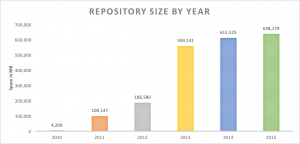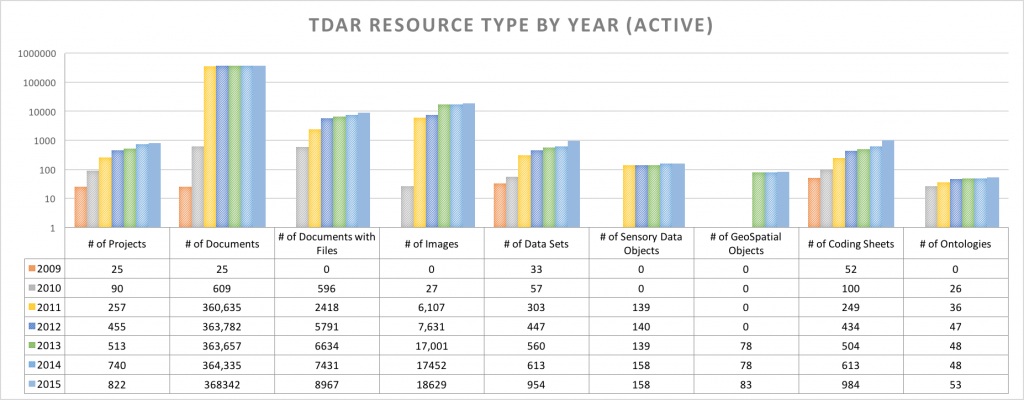We had a busy year in 2015, tDAR continued to grow with significant contributions from the North Atlantic Biocultural Organization , US Air Force, and US Army Corps of Engineers. tDAR had two major software releases, Munsell and Neolithic which completely redesigned the Data Integration interface to make it easier to use, expanded access to usage statistics, and updated the visualization and mapping interfaces for tDAR.
We are continuing our work, begun in earnest last fall with the Corps of Engineers and the US Air Force on digital archaeological archives for their bases and other facilities. We are also still working with the Phoenix Area Office of the Bureau of Reclamation and Midwest Archeological Center of the National Park Service on their rich archives of archaeological material.
As part of our continuing agreements with Archaeological Institute of America (AIA) and Society for American Archaeology (SAA), we ran workshops highlighting best practices in digital curation at the annual meetings for SAA and AIA in San Francisco and New Orleans respectively. We also continue to provide student members with a number of no cost uploads for contributing their data to tDAR as part of our agreement with SAA.
Content added to tDAR in 2015

Usage Statistics
While we do not maintain detailed statistics on users or use to protect user and contributor privacy, we can share some interesting aggregate data. Below are the most frequently viewed and downloaded resources.
Resources (most viewed)
- Big Oak Faunal Analysis, 1982 (9881)
- Fauna Taxon Ontology – Southwest US (7554)
- Prehistoric Irrigation in Arizona: Symposium 1988 (7122)
- Mimbres Pottery Images Digital Database (MimPIDD) (6920)
- Problem: Fauna Taxon Ontology – Southwest US (4969)
- Fauna Element Ontology (4900)
- Fauna Taxon Ontology – TAG (UK) (4084)
- Sapelo Island (3355)
- Fauna Taxon Ontology – Eastern US (Outdated) (2679)
- Jordan’s Journey (44PG302) (2628)
- Food Crisis in Prehistory: Overpopulation and the Origins of Agriculture (2519)
- St Bees Man: A Cold Case Review (2209)
- Outdated: Fauna Taxon – Southwest US Ontology (3028) (2178)
- Lifelines: Black Families in Chicago. In Urban Anthropology In the United States (2143)
- Standards for Data Collection from Human Skeletal Remains (1909)
- Koster Site (1828)
- Spitalfields Project (1814)
- The Archaeology of Highland Chiriqui, Panama — Documents, Images, and Datasets (1777)
- Eaton Site (1681)
- Aztec Ruin Dendro Data (1519)
Resources (most Downloaded)
- Archeological Investigations at Joshua Tree National Park, California (41)
- Tikal Report 11: Georeferenced Map- “Ruins of Tikal” (with border) (35)
- Mimbres Pottery Database (Public) (27)
- Hohokam Archaeology along the Salt-Gila Aqueduct Central Arizona Project, Volume IV: Prehistoric Occupation of the Queen Creek Delta (25)
- Petroglyphs of the Picacho Mountains, South Central Arizona (25)
- Death, Society and Ideology in a Hohokam Community: Colonial and Sedentary Period Burials from La Ciudad (24)
- The Importance of Plow Zone Archaeology (23)
- Tikal Report 11: Georeferenced Map- “Ruins of Tikal” (without border) (23)
- Grand Challenges for Archaeology – Crowd Sourcing Report (22)
- The Excavations of Los Muertos and Neighboring Ruins in the Salt River Valley, Southern Arizona (21)
- Archaeological Ethnography in Western Iran (21)
- The 1982-1984 Excavations at Las Colinas: Material Culture (20)
- Humboldt County 1947-1948 Aerial Photo Index Table (20)
- Hayden Flour Mill: Landscape, Economy, and Community Diversity in Tempe, Arizona, Volume 1: Introduction, Historical Research, and Historic Architecture (20)
- Salt River Valley Canal System (20)
- An Historic Properties Survey of the King Range National Conservation Area Located in Humboldt County, California (BLM) (20)
- Tikal Report 11: Georeferenced Map- “Ruins of Tikal” (with border) (20)
- Submerged Cultural Resources Study: USS Arizona Memorial and Pearl Harbor National Historic Landmark (20)
- The Pueblo Grande Project: Material Culture (20)
- Tikal Report 11: Georeferenced Map- “Ruins of Tikal” (with border) (20)
Culture Keywords (most used)
- Norse (95)
- Historic (46)
- Archaic (30)
- Late Archaic (22)
- Hohokam (19)
- Woodland (18)
- Ancestral Puebloan (17)
- Late Woodland (16)
- Mogollon (13)
- Middle Archaic (12)
- Historic Native American (11)
- Early Archaic (9)
- Euroamerican (9)
- PaleoIndian (9)
- Maya (8)
- Prehistoric (6)
- Spanish (6)
- Mimbres (6)
- Early Woodland (5)
- Salado (4)
Investigation Type (most used)
- Data Recovery / Excavation (198)
- Collections Research (111)
- Historic Background Research (54)
- Archaeological Overview (41)
- Reconnaissance / Survey (37)
- Ethnohistoric Research (33)
- Environment Research (31)
- Methodology, Theory, or Synthesis (30)
- Heritage Management (27)
- Architectural Survey (26)
- Research Design / Data Recovery Plan (26)
- Site Evaluation / Testing (26)
- Systematic Survey (23)
- Architectural Documentation (22)
- Records Search / Inventory Checking (21)
- Ethnographic Research (19)
- Bioarchaeological Research (10)
- Remote Sensing (5)
- Site Stewardship Monitoring (3)
- Site Stabilization (3)
Site Type (most used)
- Domestic Structure or Architectural Complex (117)
- Midden (102)
- Artifact Scatter (26)
- Settlements (23)
- Archaeological Feature (19)
- Domestic Structures (17)
- Resource Extraction/Production/Transportation Structure or Features (17)
- Hearth (11)
- Hamlet / village (10)
- Encampment (10)
- Trash midden (10)
- House (9)
- Roasting pit / oven / horno (8)
- Town / city (7)
- Rock alignment (7)
- Pit house / earth lodge (7)
- Non-Domestic Structures (6)
- Funerary and Burial Structures or Features (6)
- Quarry (6)
- Pit (5)
Material Type (most used)
- Ceramic (160)
- Chipped Stone (157)
- Ground Stone (125)
- Glass (116)
- Metal (113)
- Fire Cracked Rock (112)
- Wood (106)
- Textile (95)
- Fauna (53)
- Macrobotanical (43)
- Dating Sample (35)
- Building Materials (27)
- Human Remains (27)
- Sediment (26)
- Shell (20)
- Charcoal (14)
- Pollen (14)
- Mineral (11)
- Basketry (3)
- Ash (2)
Geographic Keywords (most used)
- Mesoamerica (591)
- North America – Southwest (398)
- South America (344)
- Europe (314)
- North America – California (192)
- AFRICA (170)
- East/Southeast Asia (162)
- North America – Southeast (160)
- North America – Midwest (126)
- West Asia (114)
- North America – NW Coast/Alaska (98)
- Central America (98)
- North America – Plains (92)
- Iceland, Lake Myvatn (92)
- Oceania (86)
- North America – Northeast (73)
- North America – Great Basin (72)
- Greenland (72)
- North Atlantic (71)
- Caribbean (63)
Site Name (most used)
- Skútustaðir (92)
- the Thomas Creek Site (4)
- SUBi-1546 (4)
- The Griffing Site (4)
- Lindesay Site (4)
- AR-03-12-06-1560(USFS) (3)
- AR-03-12-06-1551(USFS) (3)
- SUBi-895 (3)
- AR-03-12-06-1464(USFS) (3)
- NYSM #10135 (3)
- AR-03-12-06-1562(USFS) (3)
- AR-03-12-06-838(USFS) (3)
- AR-03-12-06-1584(USFS) (3)
- AR-03-12-06-942(USFS) (3)
- AR-03-12-06-959(USFS) (3)
- The Grangebel Park Site (3)
- AR-03-12-06-318(USFS) (3)
- AR-03-12-06-1558(USFS) (3)
- NYSM #10316 (3)
- AR-03-12-06-1554(USFS) (3)
Temporal Keywords (most used)
- Prehistoric (29)
- Historical (21)
- Historic (18)
- Late Archaic (10)
- 19th Century CE (10)
- Archaic (8)
- 20th Century CE (7)
- 18th Century CE (7)
- Middle Archaic (5)
- Early Archaic (5)
- Holocene (4)
- Postclassic Mimbres Period (4)
- Classic Mimbres Period (4)
- Black Mountain Phase (4)
- Pueblo IV (4)
- Early Mogollon Pithouse Period (4)
- Neolithic (4)
- Late Mogollon Pithouse Period (4)
- Basketmaker III (4)
- Mimbres Reorganization Phase (4)
Other Keywords (most used)
- Maya (163)
- Ceramics (101)
- Zooarchaeology (98)
- bioarchaeology (95)
- Geoarchaeology (69)
- Historical Archaeology (66)
- Gis (59)
- Rock Art (47)
- Ritual (45)
- Lithics (45)
- Architecture (44)
- Neolithic (42)
- Identity (41)
- Paleoethnobotany (40)
- Landscape (39)
- andes (38)
- Public Archaeology (38)
- Agriculture (35)
- Paleoindian (34)
- Archaeology (34)
People (most used)
- Aaron Kendall (2265)
- Katherine Spielmann (44)
- Rebecca Hill (34)
- Peter Kováčik (29)
- Christina Rieth (26)
- Nina Versaggi (20)
- Linda Scott Cummings (18)
- Cory D. Breternitz (17)
- Harrison Ramona (17)
- William Graves (17)
- Banks L. Leonard (17)
- Sarah Neusius (16)
- Beth Svinarich (15)
- Konrad Smiarowski (15)
- Jennifer L.B. Milligan (13)
- Keith Kintigh (13)
- Jeffrey H. Altschul (12)
- Mona Colburn (12)
- Katherine Spielmann (12)
- Rachel Horowitz (10)
Institutions (most used)
- New York State Museum (58)
- New York State Department of Transportation (57)
- PaleoResearch Institute (49)
- Federal Highway Administration (37)
- Public Archaeology Facility, Binghamton University (30)
- University Press of Colorado (30)
- Statistical Research, Inc. (21)
- Soil Systems, Inc. (17)
- SunAmerica, Inc. (17)
- SRI Press (17)
- U.S. Army Corps of Engineers, Los Angeles District (12)
- USDI Bureau of Reclamation, Phoenix Area Office (9)
- Indiana University of Penn. (7)
- US Forest Service, Tonto National Forest (6)
- New York State Education Department (5)
- Bureau of Reclamation, Phoenix Area Office (4)
- Arizona State University (ASU) (4)
- Ditz-Crane Builders, Santa Clara, California (4)
- USDI Bureau of Reclamation, Phoenix Arizona (4)



